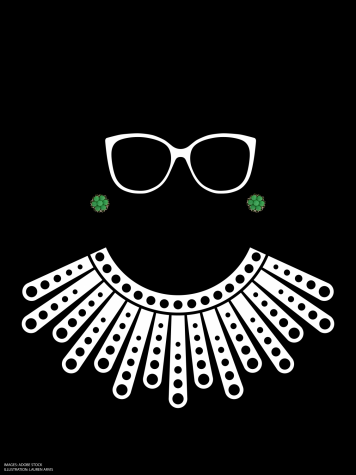Remembering Ruth Bader Ginsburg
October 31, 2020

Lace collars, sparkling brooches, and oversized spectacles—as the steadfast defender of civil rights, the five foot tall Ruth Bader Ginsburg towered over all of us. She advocated for equality, liberty and the forever-changing idea of what America is and can be. The scope of her influence and sway not only on the Supreme Court’s decisions, but also on the impact she made on all Americans can never be understated. Ginsburg died on Sept. 18. She was 87 years old.
Born Joan Ruth Bader on March 15, 1933 in Brooklyn, New York, Ginsburg grew up in a low-income, working-class neighborhood. While neither or her parents had the means to attend college, they both stressed to her the importance of learning and a strong work ethic. Sadly, Ginsburg’s mother would not be able to witness her daughter’s numerous and influential accomplishments. Celia Bader died of cancer the day before Ginsburg graduated from high school, though her influence had an everlasting effect on Ginsburg. “My mother told me two things constantly,” Ginsburg said in an interview with the ACLU. “One was to be a lady, and the other was to be independent.” It was her mother whom she thanked, when President Bill Clinton nominated Ginsburg to the Supreme Court on June 14, 1993. “I pray that I may be all that she would have been had she lived in an age when women could aspire and achieve and daughters are cherished as much as sons,” Ginsburg said upon her nomination to the Supreme Court.
Ginsburg attended Cornell University, where she studied Government. It was also where she met her husband Martin D. Ginsburg, after the pair were set up on a blind date. She graduated in 1954, and married her future husband that same year. Jane, their first child, was born shortly after Martin was drafted into the military in 1954. He served for 2 years and after his discharge, the couple enrolled in Harvard Law School. Ginsburg was one of nine women accepted in a class of more than 500 students. She went on to become the first female member of the Harvard Law Review. Later, she transferred to Columbia University, where she again joined the Law Review, and graduated first in her class.
Ginsburg then entered the job market in the 1960s, however there were few women who were hired by law firms as lawyers. She had trouble finding a job, until she was hired as a clerk by U.S. District Judge Edmund L. Palmieri, where she would work for two years. In 1963, Ginsburg accepted a job as a professor at Rutgers University Law School. While teaching, she became pregnant with James, her second child, who was born in 1965. She then accepted a job to teach at Columbia in 1972, where she became the first female professor to earn tenure. At that time, Ginsburg would also direct the American Civil Liberties Union’s newly formed Women’s Rights Project, spearheading the fight against gender discrimination cases that would build the foundation for her larger case: equal rights for women under the law.
Ginsburg believed that laws that draw distinction based on gender should be subjected to severe scrutiny under the equal protection clause of the 14th amendment. The problem was that while race discrimination was immediately labelled as intolerable and unjust, laws discriminating against women were frequently justified as protecting women. Ginsburg would go on to successfully argue six landmark cases before the Supreme Court, which would leave a lasting effect on the world today. While on the Supreme Court bench, Ginsburg would continue to make momentous decisions and dissents fighting for women’s rights, gender equality, and more.
Ginsburg is survived by her two children and grandchildren, but also by generations of women across the world who recognize her courage and determination as a foundation upon which they have built their own careers and lives. Ginsburg was and will continue to be an icon of righteousness and a symbol for equality and hope in an increasingly darkening Washington. When asked how she would like to be remembered, Ginsburg said, “Someone who used whatever talent she had to do her work to the very best of her ability. And to help repair tears in her society, to make things a little better through the use of whatever ability she has.”
In so many ways, she has achieved that.



Ethan Qin • Oct 18, 2024 at 3:23 pm
this is so good ethan!! glad to see you started journalism so early on